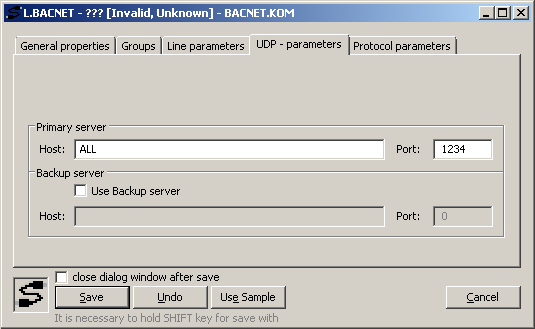Configuration of communication line of TCP/IP-UDP category.
Line of category TCP/IP-UDP was designed for the needs of communication protocols that are built directly on the UDP layer of the TCP/IP stack. Both IPv4 and IPv6 protocols are supported. The line supports also the implementation of redundant communication (redundant network lines, redundant network interfaces) and the configuration of two IP addresses of a communication partner.
The following protocols are currently supported:
TCP/IP-UDP line configuration
Primary server - Host
IP address or a network name of a computer. Depending on a specific communication protocol, it may be an IP address of a computer where the D2000 KOM process is running. In this case, symbolic addresses * or ALL (for IPv4 protocol) or [*] or [ALL] (for IPv6 protocol), representing all network interfaces where the D2000 KOM process can listen, can be entered. This is true for protocols:
In other communication protocols, this is an IP address of a partner computer, with which the D2000 KOM process communicates. This is true for protocols:
Primary server - Port
Either the number of the UDP port on which the D2000 KOM process should listen or the UDP port number on which a partner computer listens (see the description of parameter Primary server - Host).
Use Backup server
If this option is not selected, the D2000 KOM process does not work with a backup IP address/port and the line works without redundancy.
Backup server - Host
Backup IP address or network name of a computer. Depending on a specific communication protocol, it may be an IP address of a computer where the D2000 KOM process is running (see the description of parameter Primary server - Host).
Backup server - Port
Either the number of a backup UDP port on which the D2000 KOM process should listen or a backup UDP port number on which a partner computer listens (see the description of parameter Backup server - Host).
Currently, the backup server parameters are supported in the protocols SNMP, Microtel 700, and Terminal LFC (IEC 870-5).
Related pages:

Pridať komentár